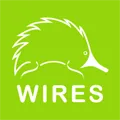Blog
Contact media@wires.org.au for enquiries or call 0416 272 153.
For the latest updates on bushfire recovery projects and emergency response
Read WIRES Emergency Recovery Plan and WIRES National Emergency Response Plan
Peregrine Falcon ingests shotgun pellets
 A rescue call came in for a Nankeen kestrel that had been taken to a
local vet in Wagga. When WIRES volunteer Shelly, arrived to pick the
bird up she found it was instead this stunning female Peregrine falcon!
A rescue call came in for a Nankeen kestrel that had been taken to a
local vet in Wagga. When WIRES volunteer Shelly, arrived to pick the
bird up she found it was instead this stunning female Peregrine falcon!
The falcon had already been x-rayed and found to have a break in her
wing. When Shelly arrived home she sent the x-rays to Hazel, WIRES local
raptor co-ordinator, who noticed a strange object in the birds crop.
It turned out to be shotgun pellet! If this had remained in her system it is very likely she would have not survived.
Shelly gave ‘Penelope’ a large meal (yum ... a rat) in the hope she
would bring up the shotgun pellet in the casting. Castings are the mass
of undigested parts of a bird’s food that they regurgitate and they are
formed within six to ten hours of their meal.
The next morning Shelly was ecstatic to discover the pellet in her
casting, a great result. When Penelope came into care she weighed only
540 grams and may have been in distress for some time. During this first
phase of her recovery Penelope had gained an impressive 340 grams.
After six weeks in care x-rays confirmed the broken bone had healed and
it was time for her to go to the aviary facility at Beechworth
Correctional Facility where she will need two to three weeks in the
large flight aviary to build up flight strength before her release.
We believe she ingested the shotgun pellet via her prey, she was
carefully checked for any signs of shot gun injury and none were found.
Shelly says she was an absolute joy to care for and to get this
magnificent bird back in the air has been the highlight of her
threeyears with WIRES.
Peregrine Falcon pairs mate for life and a breeding pair have a range of
about 20 km to 30 km. They lay their eggs in cliff faces, tree hollows
or in abandoned nests of other birds rather than constructing a nest
themselves. The female incubates the eggs and is fed by the male on the
nest. When the young have hatched, both parents are involved in hunting
to provide food.
Young Peregrine falcons disperse widely when they leave the nest, but
are known to return to their original home area to breed when mature.
If you would like to receive our rescue stories direct to your inbox each month please register for our enews today http://www.wires.org.au/contact/e-news
Search
Newsletter
Stay in touch and get our regular rescue stories, WIRES updates and a free copy of our 15 Ways to Help Wildlife ebook
Recent Posts
- Emergency Response Training for Wildlife Volunteers
- WIRES Introduces New Wildlife Rehabilitation Governance Courses in Collaboration with NPWS
- Community Support for Post-Bushfire Recovery of Wildlife in the Greater Blue Mountains
- Research Grants Program-2023 Recipients Announced
- National Koala Conference
- Nature Conservation Council's Bushfire Conference
- Support Stronger Nature Laws
- Helping Endangered Cockatoos: WIRES Grant Success Story
- Landmark Conservation Project Ensures The Future of The Northern Bettong
- Wildlife Road Collisions Unveiled
